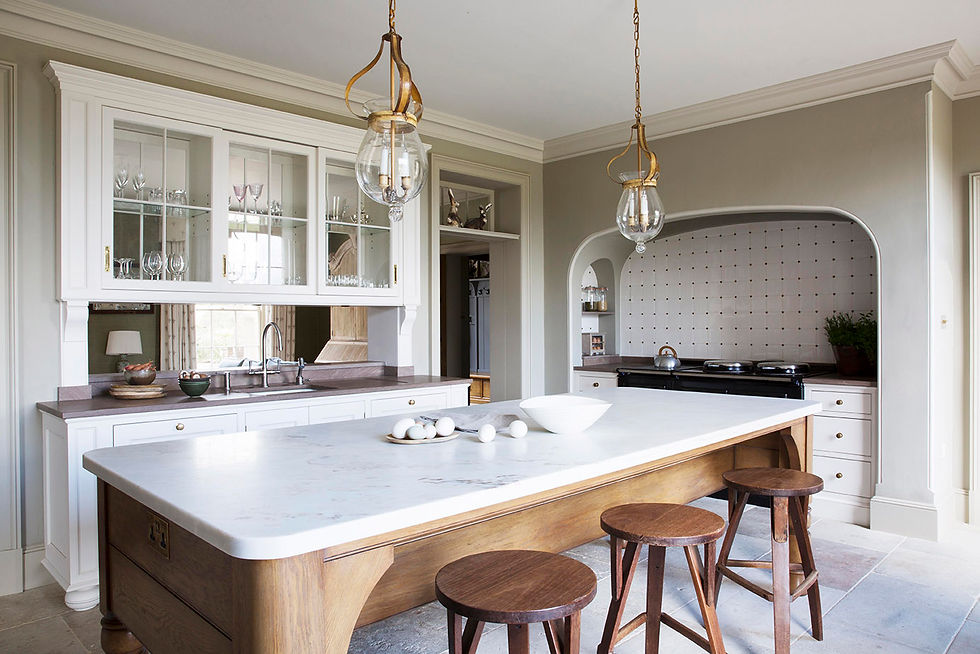How to care for Carrara marble worktops
- Jenny Kakoudakis

- Oct 26, 2019
- 3 min read

There’s marble, and then there’s Carrara Italian marble. Quarried in the Tuscan city of Carrara, it’s been revered for its beauty since ancient Roman times. This most classic of all marble is highly sought after as a touch of luxury for kitchens and elsewhere in the home. Carrara marble is milky white to grey, with a characteristically homogenous appearance and irregular blue- grey veining running through the stone that gives a beautiful, ethereal glow. Did you know that this is the
marble used by Michelangelo to create the famous David?
Closer to home, Carrara was the favoured marble for Georgian and Edwardian architecture, arguably because its understated luxury was said to reflect the characteristics of the English, and it can be found in the grandest English country houses including Chatsworth.
In today’s homes, natural stone worktops are a popular choice and when it comes to marble, Carrara leads the field. But even the most precious and stunning looking worktop needs to be maintained to keep it looking beautiful, which is why it’s important to understand how to look after your marble properly.

Above and below: Source: Artichoke
First aid for liquid spills
Despite being a natural stone surface, Carrara marble is actually quite delicate and porous. The light colour can stain permanently if spills are not dealt with promptly, and the darker the colour of the spilt liquid (think red wine, beetroot or blackcurrant juice!), the worse it can be. Once the liquid has penetrated into the pores in the marble surface, it can make them almost impossible to remove with a conventional marble cleaner – you have been warned.
When a spill has occurred, the trick is to act quickly. Mop up everything with a tea towel (ideally a white one, so you can see when the stain is completely removed), rinse with water and dry. You can also use a specialist marble cleaner, spraying the affected area and wiping down the surface with a clean tea towel.
You may use warm soapy water, but be advised that frequent use over time can dull the shine of your marble, so be careful. For ink stains on marble, use a mixture of water and bleach. Food stains may lift with hydrogen peroxide.
Once you’ve completed the cleaning step, wipe down the marble worktop with a chamois leather or microfibre cloth until the surface is completely dry. Water left on the marble surface may also cause staining.
If the spill was from an acidic liquid such as wine, fruit juice or vinegar, the acid can quickly etch the marble surface and a stain may be left behind unless you react with lightning speed to remove the spillage. An etch mark occurs when the acid reacts with the marble and dissolves part of the top surface. You can actually feel this when you run your hand over the affected area. Removing an etch mark requires re-polishing the marble surface.

Regular marble maintenance
It goes without saying that your Carrara marble surface should be cleaned regularly, ideally after each use and certainly once a day, as part of your general kitchen hygiene routine.
First, wipe down the worktop surface with a damp cloth to remove any debris that could scratch the stone, then spray on marble cleaner and wipe off with a soft cloth or paper towel. Finally, buff the surface dry with a chamois or microfibre towel to avoid water marks.
If you choose to clean your marble surface with a household detergent, try and choose one that is as alkaline a possible and stay away from anything acidic that may attack the surface of the marble. Even lemon scented washing up liquid may be too harsh for the delicate stone.
Luckily, looking after your Carrara marble worktop is not difficult, but it does need doing every day. With regular care and attention, and essential knowledge about the do’s and don’ts of marble care, you will be able to keep the worktop clean and protect your kitchen investment in the long term.


Sealing Carrara marble
Usually, marble is delivered either as honed or polished. The honed finish is more scratch resistant but any spills soak in faster and easier than with a polished worktop. The polished finish acts as a type of protection against stains but it makes it more vulnerable to scratching.
As already mentioned, Carrara marble is more delicate than you may think. The best way to protect this kitchen surface from spills, permanent stains and etch marks is by sealing it. By impregnating the marble’s pores to block foreign substances from penetrating the naturally porous stone, any moisture is kept out and no stain can develop. All marble should be sealed at least once a year, perhaps more in areas of heavy use.
Choose from topical sealers made from polyurethanes, acrylics or natural wax that act as a surface barrier, or penetrating sealers containing siliconates, fluoro-polymers and siloxanes that penetrate deeper and offer longer lasting protection.


